Anna Satyana Karyawati, S. M. Sitompul, Nur Basuki, Sitawati
Faculty of Agriculture, Brawijaya University, Malang, Indonesia
Correspondence to: Anna Satyana Karyawati, Faculty of Agriculture, Brawijaya University, Malang, Indonesia.
| Email: |  |
Copyright © 2015 Scientific & Academic Publishing. All Rights Reserved.
This work is licensed under the Creative Commons Attribution International License (CC BY).
http://creativecommons.org/licenses/by/4.0/

Abstract
Thirty (30) genotypes from F1 were obtained from six soybean strains (Anjasmoro, Tanggamus, Argopuro, Grobogan, Brawijaya 2 and Brawijaya 1) which the diallel cross scheme. These genotypes were used to analyze the combining ability and maternal effect of physiological characters in soybean strains such asCO2 exchange rates (CER), intercellular CO2 concentration (Ci), stomatal conductance (SC), transpiration (E), plant height, number of branch, fertile nodes, filled pods, seeds per plant, weight of seeds per plant and weight of 100 seeds. The result showed that Tanggamus, Brawijaya 2, Brawijaya 1 strains have positive general combining ability and significantly different from the other strains, thus these strains have a good possibility to crossed with others. Brawijaya 2 (male) x Tanggamus (female), Brawijaya 2 x Argopuro, Argopuro x Brawijaya 1, Brawijaya 1 x Grobogan, Brawijaya 1 x Brawijaya 2, and Brawijaya 1 x Argopuro were the selected genotypes which have positive specific combining ability from most of character observed.
Keywords:
General combining ability (GCA), Specific combining ability (SCA), Physiological character, Soybean
Cite this paper: Anna Satyana Karyawati, S. M. Sitompul, Nur Basuki, Sitawati, Combining Ability Analysis for Physiological Characters of Soybean (Glycine max L. Merrill), International Journal of Plant Research, Vol. 5 No. 5, 2015, pp. 113-121. doi: 10.5923/j.plant.20150505.04.
1. Introduction
Soybean production in Indonesia has not been able to fulfill the public requirement as a result of low productivity and limited planting area. BPS data showed that from 554.132 ha planting area, yielded 807,568 ton and 14.57 cu.ha-1 [1]. Low productivity of soybean can be caused by (i) declining of planting area and yield, (ii) low productifity (iii) competition between local soybean and imported comodities and (iv) small number of soybean farmer land ownership [2]. The local soybean strains used still could not reach higher yields. Therefore, it is necessary to improve the productivity of local soybean plants.The research to increase the local soybean yield has been done and continues to do. Attempts to improve the soybean yields can be done through genetic and non-genetic improvement. This genetic improvement can be done through crossbreeding and selection [3]. Diallel cross is genetic cross experiment to separate genetic influences from environment to control a quantitative character. Diallel cross technique was developed to obtain information about genetic mechanisms involved in the initial generation [4]. In diallel cross also possible to choose the parental [5].The combining ability experiment can be done with diallel cross using cross combination between inbred strains exist [6], and all of genotypes have the opportunity to crossed in all combinations [7, 8] stated that diallel analysis could be used to understand general and specific combining ability from parental used in crossing and using a number of assumptions to determine the nature and genetic parameters. A diallel cross also used to identify the potential parental of general and specific combining ability [9]. Most of general and specific combining ability were arranged in various roles of genes. General combining ability variance consist of variety of additives, whereas specific combining ability variance consists of a variety of dominant [7, 10].Some studies about diallel cross analysis on the nutritional content characters of soybean as well as resistance to biotic stresses such as diseases has been widely reported [11, 12, 13]. Production and seed vigor in soybeans were controlled by the action of the additive and non-additive genes. The effect of additive variance is greater than non-additive variance on production and seed vigor [11, 14]. Tukamuhabwa et al. [12] reported the diallel cross analysis using half diallel population on broken pods character of soybean. The result showed that there is an interaction between genes locus (epistasis) which control the broken pods character and it was partially dominant. The resistance of red root disease caused by Fusarium solani f. sp. glycines is over dominance and controlled by at least three dominant genes. The narrow sense of heritability values for the red root disease resistance ranges between 48.0-62.0%, and the broad sense of heritability ranges between 90.0-95.0% [15].This research aims to study the combining ability and the influence of maternal effect on physiological character of soybean, to provide the basic population and support the effectiveness of selection activities.
2. Research Methods
This research conducted in Research Station of Indonesian Legumes and Tuber Crops Research Institute (ILETRI), Kendalpayak, Malang on Mei–September 2013. The genetic material used were 30 genotypes from F1 cross of 6 parental strains (Anjasmoro, Tanggamus, Argopuro, Grobogan, Brawijaya 2 and Brawijaya 1) which crossed diallelly in method-3 [9]. The research design used was randomized block design with 30 combination of F1 cross as treatment with 5 times repetition for each plant (1 plant per repetition).The seeds of each genotype were planted on 10 kg size of polybag consist of 2:1 soil and manure fertilizer mixture, with one seed per planting hole. After one week, 2/3 Urea fertilizer doses with 50 kg.ha-1; SP-36 100 kg.ha-1 and KCl 100 kg.ha-1 were given and 1/3 Urea fertilizer doses was given after three weeks.The maintenance until plants harvested was correspond to optimum soybean cultivation techniques, including irrigation, pest and disease control. Plants were harvested by unplugged from medium after reaching physiological maturity with characteristics of yellowing leaves as much as 90% and brownish colored pods.CO2 Exchange Rate (CER), intercellular CO2 concentration (Ci), stomatal conductance (SC) and transpiration (E) were observed and analyzed at PAR 500 µmol.m-2.s-1 using LI-6400 Portable Photosynthesis System of Li-Cor Biosciences, Inc. Lincoln, Nebraska, USA [16]. The observation were done for each plant at vegetative stage, 30 days after planted for plant height (cm), number of branch, fertile nodes, filled pods, seeds per plant, weight of seeds per plant (gram) and weight of 100 seeds (gram).
2.1. Data Analysis
Data were analyzed using diallel cross analysis based on Griffing Method-3 with statistic model as follows:
 Total population variance was split into general combining ability, specific combining ability, reciprocal and error. The estimation of general combining ability for parental, specific combining ability for crossing and reciprocal as follows [17]:
Total population variance was split into general combining ability, specific combining ability, reciprocal and error. The estimation of general combining ability for parental, specific combining ability for crossing and reciprocal as follows [17]: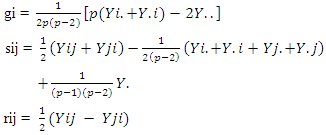
3. Result and Discussion
3.1. CO2 Exchange Rate (CER)
Based on general combining ability analysis, parental CER character was significantly varied (Table 1), means potential parental with positive general combining ability if crossed to other genotypes were founded. Two genotypes which have positive general combining ability on CER i.e. Tanggamus (TGM) and Brawijaya 1 (BRW1) (Table 2).Table 1. Mean squares of crossing, general combining ability (GCA), specific combining ability (SCA) and reciprocal on physiological characters of F1 soybean
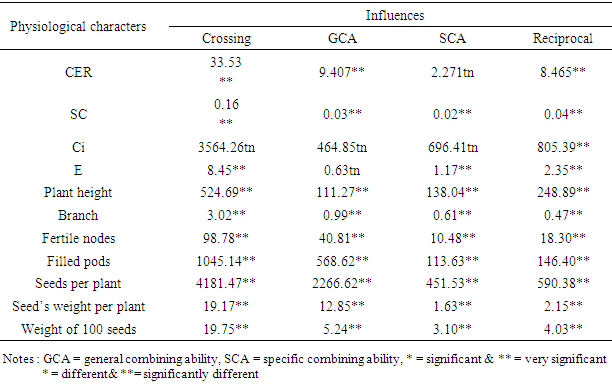 |
| |
|
Table 2. Influence of general combining ability and physiological characters of six soybean parentals
 |
| |
|
Variance of specific combining ability analysis showed that the variance of 30 genotypes of F1 cross not significantly different and reciprocal influence affects CER character (Table 1). Reciprocal influences showed the genotypes pair were affected by female parental. Six cross reciprocal pairs were found affected by female parental which control CER character, i.e. Argopuro (male) x Brawijaya 2 (female); Groboganx Anjasmoro; Tanggamus x Anjasmoro; Tanggamus x Brawijaya 2; Tanggamus x Argopuroand Brawijaya 1 x Brawijaya 2. Grobogan x Anjasmorowas known to have positive and biggest value of specific combining ability (Table 3).Table 3. Effects of specific combining ability for character of photosynthetic rate (CER = Carbon Exchange Rate, µmol CO2 m-2s-1) on crop F1 (above diagonal) and F1 reciprocal (below diagonal) crossbred of soybean
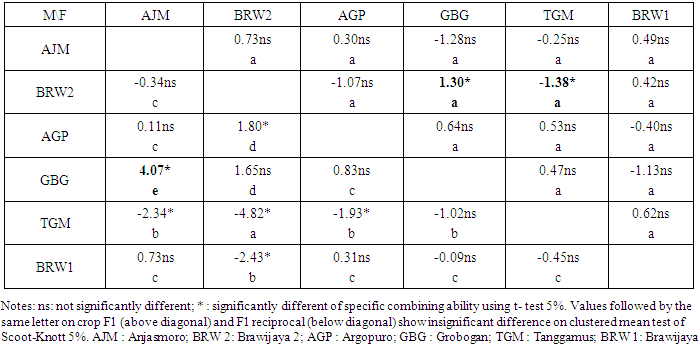 |
| |
|
3.2. Intercellular CO2 Concentration (Ci)
Based on analysis of variance, there are no significant differences between 30 cross combination for intercellular CO2 concentration (Ci) character (Table 1), which showed that each genotype has no difference on Ci performance. Significant differences of parental specific combining ability on Ci character of leaves were not founded which means each genotype have the same effect when crossed with others (Table 1). No significant difference on specific combining ability variance and reciprocal influences means there are no genotype pair which have positive Ci performance of on leaves. This is also means that crossed genotypes does not have genetic potential inherited from generation to generation for intercellular CO2concentration (Ci) character on leaves (Table 2) and there is no crossed pair which controlled by female parental (Table 4).Table 4. Effects of specific combining ability for character of CO2 internal (Ci) concentration (µmol CO2.mol-1) on crop F1 (above diagonal) and F1 reciprocal (below diagonal) crossbred of soybean
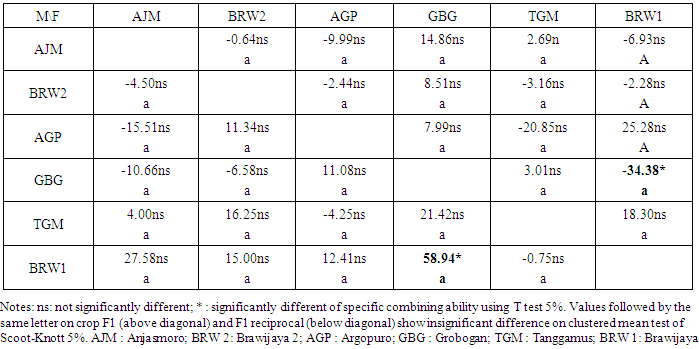 |
| |
|
3.3. Stomatal Conductance (SC)
Significant differences of stomatal conductance (SC) character on 30 genotypes from F1 cross were founded (Table 1). General combining ability of parental genotypes on SC have a significant difference, which means there is potential parental which can be crossed with others and will show positive general combining ability (Table 1). Strain Grobogan was founded as the genotype which have positive GCA (Table 2). Significant differences of specific combining ability (SCA) and reciprocal influence also founded in this character, which means the genotypes pair have positive performance on combining ability and affected by female parental (Table 1). Argopuro (male) x Brawijaya 1 (female) give a positive performance and significantly different on SC character. Genotypes reciprocal pair which have positive influence of SCA is Brawijaya 1 (male) x Grobogan (female) (Table 5).Table 5. Effects of specific combining ability on character of stomatal conductivity (SC) (mol H2O m-2.s-1) on crop F1 (above diagonal) and F1 reciprocal (below diagonal) crossbred of soybean
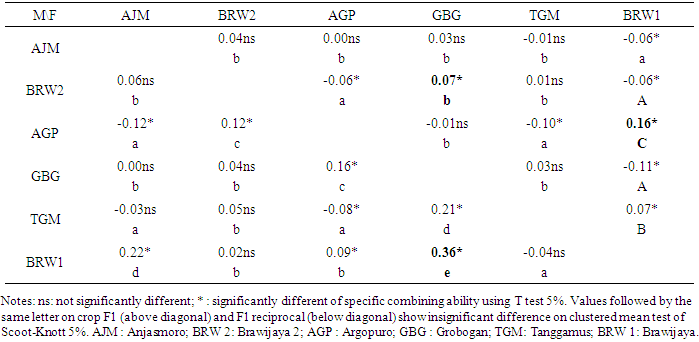 |
| |
|
3.4. Transpiration (E)
Based on analysis of variance, significant difference was founded from 30 genotypes for transpiration (E) character (Table 1). Significant difference of GCA on transpiration character of parental genotypes was not founded (Table 1), which means crossing over between parental will generate same genotypes and there is no genetic potential inherited from generation to generation for transpiration (E) character (Table 4).From SCA analysis and reciprocal effect known that this character is significantly different, which showed that these genotype pairs has positive performance of combining ability and affected by female parental (Table 1). Six pairs with positive GCA of transpiration character were founded i.e. Anjasmoro (male) x Grobogan (female); Anjasmoro x Grobogan; Brawijaya 2 x Grobogan; Brawijaya 2 x Brawijaya 1; Argopuro x Brawijaya 1 and Tanggamus x Brawijaya 1, and three pairs of reciprocal crossing with positive SCA also founded i.e. Argopuro (male) x Brawijaya 2 (female); Brawijaya 1 x Anjasmoro and Brawijaya 1 x Grobogan (Table 6).Table 6. Effects of specific combining ability for transpiration character (E) (µmol H2O m-2.s-1) on crop F1 (above diagonal) and F1 reciprocal (below diagonal) crossbred of soybean
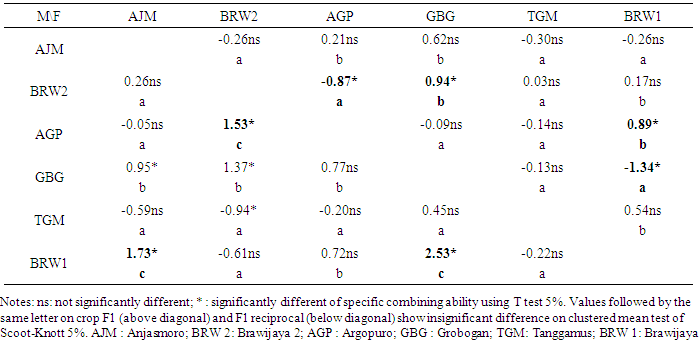 |
| |
|
3.5. Plant Height
Plant height character of 30 genotypes from F1 cross showed a significant difference (Tabel 1), which means positive GCA for plant height character was founded and these potential parental genotypes are good when crossed with others i.e.Brawijaya 2, Grobogan and Tanggamus (Table 2). Based on combining analysis, plant height character have significant differences on SCA and reciprocal effect (Tabel 1) which showed these genotype pairs haspositive performance of combining ability and affected by female parental. Nine pairs were founded with positive SCA on plant height character i.e. Anjasmoro (male) x Argopuro (female); Anjasmoro x Tanggamus; Anjasmoro x Brawijaya 1; Brawijaya 2 x Grobogan; Brawijaya 2 x Tanggamus; Argopuro x Grobogan; Argopuro x Brawijaya 1; Grobogan x Tanggamus; Grobogan x Brawijaya 1 and two pairs of reciprocal crossing with positive SCA also founded i.e.Brawijaya 1 (male) x Brawijaya 2 (female) andBrawijaya 1 x Grobogan (Table 7).Table 7. Effects of specific combining ability for plant height character (cm) on crop F1 (above diagonal) and F1 reciprocal (below diagonal) crossbred of soybean
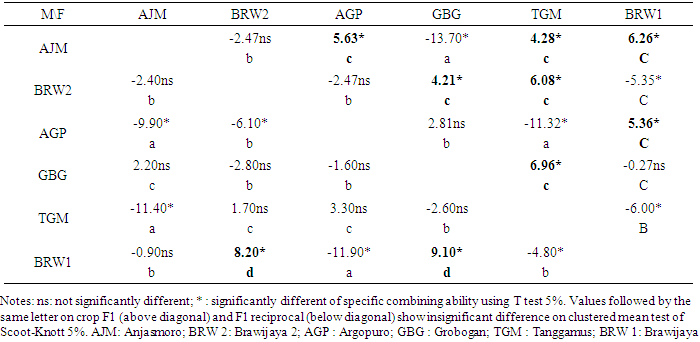 |
| |
|
3.6. Number of Branch
Branch number of 30 genotypes fromF1 cross showed a significant difference (Table 1), which means positive GCA for branch number character was founded and these potential parental genotypes are good when crossed with others i.e. Brawijaya 2, Tanggamus and Brawijaya 1 (Table 2).From SCA analysis and reciprocal effect known that this character has significant difference, which means these genotype pair has positive performance of combining ability and affected by female parental (Table 1). Brawijaya 2 (male) x Tanggamus (female) was founded with positive SCA on branch number character and four pairs of reciprocal crossing with positive SCA also founded i.e. Brawijaya 2 (male) x Anjasmoro (female); Brawijaya 1 x Brawijaya 2; Brawijaya 1 x Argopuro; Brawijaya 1 x Grobogan (Table 8).Table 8. Effects of specific combining ability for numbers of branch character on crop F1 (above diagonal) and F1 reciprocal (below diagonal) crossbred of soybean
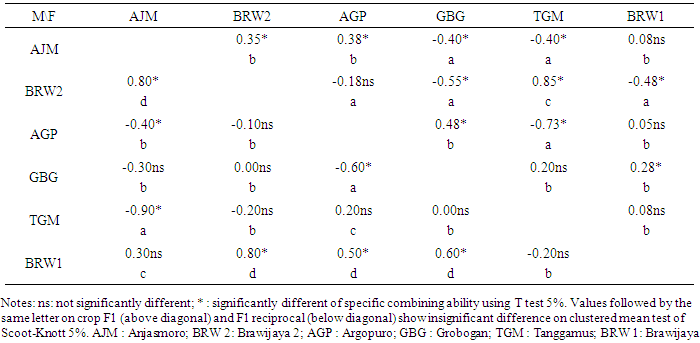 |
| |
|
3.7. Fertile Nodes
Based on analysis of variance, significant difference was founded from 30 genotypes of F1 cross for number of fertile nodes character (Table 1) which means positive GCA was founded and this potential parental genotypes are good when crossed with others. Brawijaya 1 strain provides positive GCA for fertile nodes number character (Table 2). Significant differences of specific combining ability (SCA) and reciprocal influence also founded in this character, which means the genotype pairs has positive performance on combining ability and affected by female parental (Table 1). Anjasmoro (male) x Argopuro (female); Brawijaya 2 x Tanggamus; Argopuro x Grobogan and Tanggamus x Brawijaya 1 were founded with positive SCA on number of fertile nodes character and Brawijaya 1 (male) x Brawijaya 2 (female) and Brawijaya 1 x Grobogan were also founded as reciprocal crossing with positive SCA (Table 9).Table 9. Effects of specific combining ability for numbers of fertile node character on crop F1 (above diagonal) and F1 reciprocal (below diagonal) crossbred of soybean
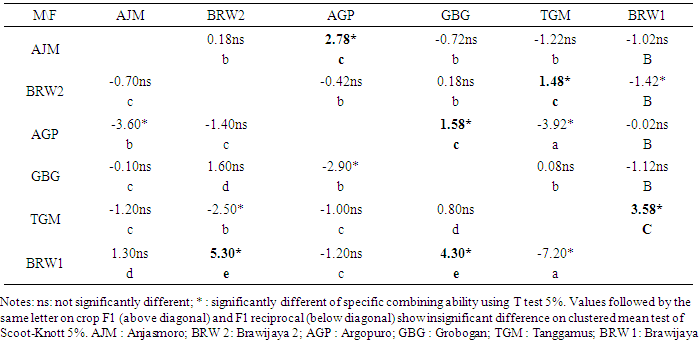 |
| |
|
3.8. Filled Pods
Significant differences of number of filled pods per plant character on 30 genotypes from F1 cross were founded (Table 1). General combining ability of parental genotypes on filled pods have a significant differences, which means there is potential parental which can be crossed with others and will show positive general combining ability (Table 1). Brawijaya 2, Tanggamus and Brawijaya 1 strains were founded as the genotype which have positive GCA (Table 2).Significant differences of specific combining ability (SCA) and reciprocal influence also founded in this character, which means the genotypes pairs have positive performance on combining ability and affected by female parental (Table 1). Brawijaya 2 (male) x Argopuro (female); Brawijaya 2 x Tanggamus and Argopuro x Grobogan were given a positive performance and significantly different on number of filled pods character. Genotype reciprocal pairs which have positive influence of SCA are Brawijaya 1 x Brawijaya 2; Brawijaya 1 x Argopuro and Brawijaya 1 x Grobogan (Table 10).Table 10. Effects of specific combining ability for numbers of filled pod character on crop F1 (above diagonal) and F1 reciprocal (below diagonal) crossbred of soybean
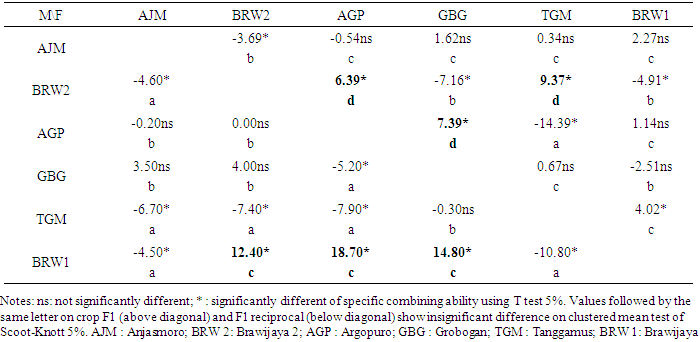 |
| |
|
3.9. Seeds Per Plant
Seeds per plant character of 30 genotypes from F1 cross showed a significant difference (Table 1), which means positive GCA for seeds per plant character was founded and these potential parental genotypes are good when crossed with others i.e. Brawijaya 2, Tanggamus and Brawijaya 1 (Table 2). Based on combining analysis, seeds per plant character have significant difference on SCA and reciprocal effect (Table 1), which showed that these genotype pairs has positive performance of combining ability and affected by female parental. Three pairs were founded with positive SCA on seeds per plant character i.e. Brawijaya 2 (male) xArgopuro (female); Brawijaya 2 x Tanggamus and Argopuro x Grobogan and three pairs of reciprocal crossing with positive SCA also founded i.e. Brawijaya 1 x Brawijaya 2; Brawijaya 1 x Argopuro and Brawijaya 1 x Tanggamus (Table 11).Table 11. Effects of specific combining ability for numbers of seeds character on crop F1 (above diagonal) and F1 reciprocal (below diagonal) crossbred of soybean
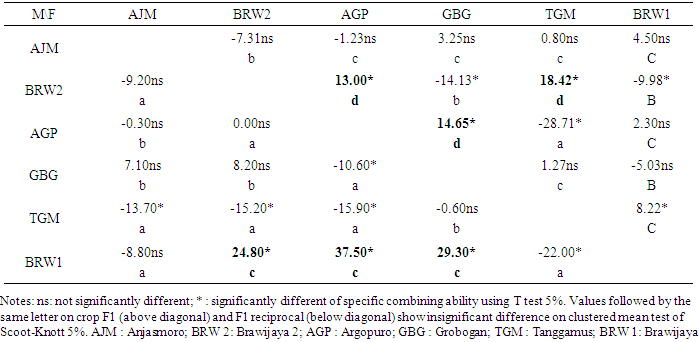 |
| |
|
3.10. Weight of Seeds Per Plant
Significant differences of cross combination on 30 genotypes from F1 cross were founded in weight of seeds per plant character (Table 1). This character also showed positive GCA and this potential parental genotypes (Brawijaya 2) is good when crossed with others (Table 2).Significant differences of specific combining ability (SCA) and reciprocal influence also founded in this character, which means these genotype pairs has positive performance on combining ability and affected by female parental (Table 1). Anjasmoro (male) x Argopuro (female); Anjasmoro x Brawijaya 1; Brawijaya 2 x Argopuro; Brawijaya 2 x Tanggamus; Brawijaya 2 x Brawijaya 1; Argopuro x Grobogan; Grobogan x Tanggamus were given a positive performance and significantly different on weight of seeds per plant character (Table 12). Genotype reciprocal pairs which have positive influence of SCA are Grobogan (male) x Brawijaya 2 (female); Grobogan x Argopuro; Brawijaya 1 x Brawijaya 2; Brawijaya 1 x Argopuro; and Brawijaya 1 x Grobogan (Table 12).Table 12. Effect of specific combining ability for character weight of seeds per crop (g) on crop F1 (above diagonal) and F1 reciprocal (below diagonal) crossbred of soybean
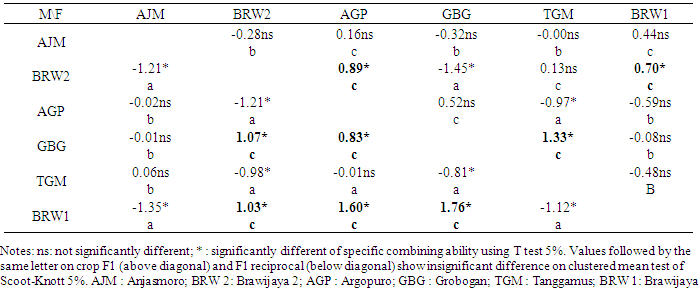 |
| |
|
3.11. Weight of 100 Seeds
Based on analysis of variance, weight of 100 seeds per plant character of 30 genotypes from F1 cross showed a significant difference (Table 1). This character showed positive GCA and Grobogan genotype is a good potential parental when crossed with others (Table 2).Specific combining ability (SCA) and reciprocal effect also has a significant difference in weight of 100 seeds character (Table 1). These genotype pairs has positive performance of combining ability and affected by female parental i.e. Brawijaya 2 (male) x Brawijaya 1 (female) and Argopuro x Tanggamus and two pairs of reciprocal crossing with positive SCA also founded i.e.Grobogan (male) x Argopuro (female) and Tanggamus x Argopuro (Table 13).Table 13. Influence of specific combining abilityon weight of 100 peas per plantcharacter in soybean crossing
 |
| |
|
4. Conclusions
1. Tanggamus, Brawijaya 2, Brawijaya 1 strains has positive general combining ability (GCA) and significantly different with the other strains, also have a good possibility to be paired with other strains.2. All of physiological characters observed not only controlled by nucleic genes, but also cytoplasmic genes.3. Crossing over between Brawijaya 2 (male) x Tanggamus (female), Brawijaya 2 x Argopuro, Argopuro x Brawijaya 1, Brawijaya 1 x Grobogan, Brawijaya 1 x Brawijaya 2, and Brawijaya 1 x Argopuro are selected genotypes which have positive specific combining ability (SCA) from most of characters observed.
ACKNOWLEDGEMENTS
The author would like to thank the Head of Indonesian Legumes and Tuber Crops Research Institute (ILETRI), Malang upon facilities provided and also to Director of Directorate General of Higher Education (DGHE), Ministry of Research (DIKTI) for BPPDN scholarship.
References
| [1] | Badan Pusat Statistik, 2013, Produksi padi, jagung dan kedelai. Berita Resmi Statistik No.20/03/Th.XVI:1-9. |
| [2] | Kementan, 2013, Pedoman teknis pengelolaan produksi kedelai, Indonesia. |
| [3] | Khan, A.S and I. Habib., 2003, Gene action in five parent diallel cross of spring wheat (Triticumaestivum L.), Pakistan J. Bio. Scien., 6:1945-1948. |
| [4] | Squire, G.R., 1993, The physiology of tropical crop production.C.P.B. International. Wallingford (UK). |
| [5] | De Sousa, J.A. and W.R. Maluf., 2003, Diallel analysis and estimation of genetic parameters of hot pepper (Capsicum chinense. Jacq), Scien. Agricola, 60(1), 105-113. |
| [6] | Ruswandi D, Hautea, Carpena, Lantican, Salazar, and Raymundo., 2002, Quantitative trait loci maping of Philippine downy mildew resistance gene in mayze (Zea mays L.) Zuriat, 13(1), 27-34. |
| [7] | Roy, D., 2002, Plant breeding: analysis and exploitattion of variation, Narosa Publishing House, Calcutta. |
| [8] | Alia, Y., dan W. Wilia., 2011, Persilangan empat varietas kedelai dalam rangka penyediaan populasi awal untuk seleksi, Jurnal Penelitian Universitas Jambi Seri Sains, 13(1), 39 – 42 |
| [9] | Griffing, B., 1956, Concept of general and specific of combining ability in relation to diallel crossing systems. Aust. J.Sci., 9:463-493. |
| [10] | Hayman, B.I., 1954, The theory and analysis of diallel crosses, Genetics, 39:701-809. |
| [11] | Cho, Y and R.A. Scott, 2000, Combining ability of seed vigor and seed yield in soybean, Euphytica 112:145-150. |
| [12] | Tukamuhabwa P., P. Rubaihayo., and K.E., 2002, Dashiel, Genetic component of pod shattering in soybean. Euphytica 125: 29-34. |
| [13] | Fronza, V., N.A. Velo, L.E.A. Camargo, 2004, Genetic Analysis of Soybean Resistance to Fusariumsolanif.sp. glycines. Genet. Mol. Biol., 27(3), 1-14 |
| [14] | Pantalone VR, Burton, and Carter, 1996, Soybean fibrous root heritability and genotipic correlations with agronomic and seed quality traits. Crops Science. 36: 1120-1125. |
| [15] | Vello NA, and E.A.C. Luis, 2004, Genetic analysis of soybean resistance to Fusariumsolani f. sp.glycines Genet MolBiol, 27(3), 1-14. |
| [16] | Anonymous, 2007, Instruksi kerja Li-COR, Laboratorium Fisiologi Tumbuhan Jurusan Budidaya Pertanian Fakultas Pertanian Universitas Brawijaya. Malang. |
| [17] | Singh, R.K and B.D. Chaudary, 1979, Biometrical Method In Quantitative Genetics Analysis. Kalyani Publisher, New Delhi. |




 Total population variance was split into general combining ability, specific combining ability, reciprocal and error. The estimation of general combining ability for parental, specific combining ability for crossing and reciprocal as follows [17]:
Total population variance was split into general combining ability, specific combining ability, reciprocal and error. The estimation of general combining ability for parental, specific combining ability for crossing and reciprocal as follows [17]:
 Abstract
Abstract Reference
Reference Full-Text PDF
Full-Text PDF Full-text HTML
Full-text HTML











